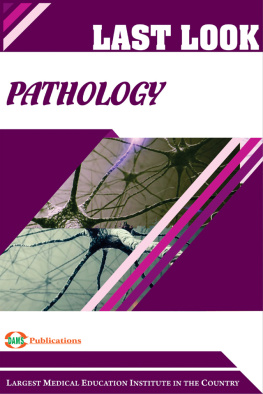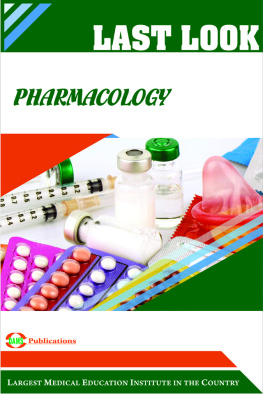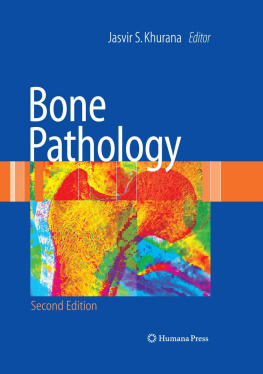DAMS - LAST LOOK: Pathology
Here you can read online DAMS - LAST LOOK: Pathology full text of the book (entire story) in english for free. Download pdf and epub, get meaning, cover and reviews about this ebook. City: New Delhi, year: 2018, publisher: Delhi Academy of Medical Sciences (P) Ltd., genre: Detective and thriller. Description of the work, (preface) as well as reviews are available. Best literature library LitArk.com created for fans of good reading and offers a wide selection of genres:
Romance novel
Science fiction
Adventure
Detective
Science
History
Home and family
Prose
Art
Politics
Computer
Non-fiction
Religion
Business
Children
Humor
Choose a favorite category and find really read worthwhile books. Enjoy immersion in the world of imagination, feel the emotions of the characters or learn something new for yourself, make an fascinating discovery.
- Book:LAST LOOK: Pathology
- Author:
- Publisher:Delhi Academy of Medical Sciences (P) Ltd.
- Genre:
- Year:2018
- City:New Delhi
- Rating:3 / 5
- Favourites:Add to favourites
- Your mark:
- 60
- 1
- 2
- 3
- 4
- 5
LAST LOOK: Pathology: summary, description and annotation
We offer to read an annotation, description, summary or preface (depends on what the author of the book "LAST LOOK: Pathology" wrote himself). If you haven't found the necessary information about the book — write in the comments, we will try to find it.
DAMS: author's other books
Who wrote LAST LOOK: Pathology? Find out the surname, the name of the author of the book and a list of all author's works by series.
LAST LOOK: Pathology — read online for free the complete book (whole text) full work
Below is the text of the book, divided by pages. System saving the place of the last page read, allows you to conveniently read the book "LAST LOOK: Pathology" online for free, without having to search again every time where you left off. Put a bookmark, and you can go to the page where you finished reading at any time.
Font size:
Interval:
Bookmark:
LAST LOOK Pathology  LAST LOOK Pathology
LAST LOOK Pathology  Largest Medical Education Institute in the Country
Largest Medical Education Institute in the Country  Published by Delhi Academy of Medical Sciences (P) Ltd.HEAD OFFICE Delhi Academy of Medical Sciences (P.) Ltd. 4-B, Grovers Chamber, Pusa Road, Near Karol Bagh Metro Station, New Delhi-110 005 Phone : 011-4009 4009 http://www.damsdelhi.com Email: info@damsdelhi.com ISBN : First Published 1999, Delhi Academy of Medical Sciences 2018 DAMS Publication All rights reserved. No part of this book may be reproduced or transmitted in any form or by any means, electronic, mechanical, including photocopying, recording, or any information storage and retrieval system without permission, in writing, from the author and the publishers. This book contains information obtained from authentic and highly regarded sources. Reprinted material is quoted with permission. Reasonable efforts have been made to publish reliable data and information, but the authors and the publishers cannot assume responsibility for the validity of all materials.
Published by Delhi Academy of Medical Sciences (P) Ltd.HEAD OFFICE Delhi Academy of Medical Sciences (P.) Ltd. 4-B, Grovers Chamber, Pusa Road, Near Karol Bagh Metro Station, New Delhi-110 005 Phone : 011-4009 4009 http://www.damsdelhi.com Email: info@damsdelhi.com ISBN : First Published 1999, Delhi Academy of Medical Sciences 2018 DAMS Publication All rights reserved. No part of this book may be reproduced or transmitted in any form or by any means, electronic, mechanical, including photocopying, recording, or any information storage and retrieval system without permission, in writing, from the author and the publishers. This book contains information obtained from authentic and highly regarded sources. Reprinted material is quoted with permission. Reasonable efforts have been made to publish reliable data and information, but the authors and the publishers cannot assume responsibility for the validity of all materials.
Neither the authors nor the publishers, nor anyone else associated with this publication, shall be liable for any loss, damage or liability directly or indirectly caused or alleged to be caused by this book. Neither this book nor any part may be reproduced or transmitted in any form or by any means, electronic or mechanical, including photocopying, microfilming and recording, or by any information storage or retrieval system, without permission in writing from Delhi Academy of Medical Sciences. The consent of Delhi Academy of Medical Sciences does not extend to copying for general distribution, for promotion, for creating new works, or for resale. Specific permission must be obtained in writing from Delhi Academy of Medical Sciences for such copying. Trademark notice: Product or corporate names may be trademarks or registered trademarks, and are used only for identification and explanation, without intent to infringe. Typeset by Delhi Academy of Medical Sciences Pvt.
Ltd., New Delhi (India).
| ||
Infiltration and embedding in paraffin V. Sectioning with a microtome VI. Mounting on microscope slides VII. Clearing and Staining VIII. Preparation of permanent mounts Formaldehyde, as 10% neutral buffered formalin (NBF) is the most common fixative used in diagnostic pathology. Formalin is used for all routine surgical pathology and autopsy tissues when an H and E slide is to be produced.
Zenker's fixatives are recommended for reticuloendothelial tissues including lymph nodes, spleen, thymus, and bone marrow. Zenker's fixes nuclei very well and gives good detail. Bouin's solution is sometimes recommended for fixation of testis, GI tract, and endocrine tissue. Glutaraldehyde is recommended for fixation of tissues for electron microscopy. Alcohols, specifically ethanol, are used primarily for cytologic smears. Ethanol (95%) is fast and cheap.
Since smears are only a cell or so thick, there is no great problem from shrinkage, and since smears are not sectioned, there is no problem from induced brittleness. For fixing frozen sections, you can use just about anything-- though methanol and ethanol are the best Formic acid in a 10% concentration is the best all-around decalcifier. The presence of a fine black precipitate on the slides, often with no relationship to the tissue (i.e., the precipitate appears adjacent to tissues or within interstices or vessels) suggests formalin-heme pigment has formed. This can be confirmed by polarized light microscopy, because this pigment will polarize a bright white (and the slide will look like many stars in the sky). Tissues such as spleen and lymph node are particularly prone to this artefact. SPECIAL STAINSMucin stains There are a variety of mucin stains, all attempting to demonstrate one or more types of mucopolysaccharide substances in tissues.
The types of mucopolysaccharides are as follows:
| Type of mucin | PAS | Alcian blue |
| Neutral | Positive | Negative |
| Acid simple- epithelial | Positive | Positive at pH 2.5 |
| Acid simple- mesenchymal | Negative | Positive at pH 2.5 |
| Acid complex | Positive | Positive at pH 1 |
The section is treated with dilute hydrochloric acid to release ferric ions from binding proteins. These ions then react with potassium ferrocyanide to produce an insoluble blue compound (the Prussian blue reaction) Calcium stains Only calcium that is bound to an anion (such as PO4 or CO3) can be demonstrated. Calcium forms a blue-black lake with hematoxylin to give a blue color on H&E stain, usually with sharp edges. VonKossa stain is a silver reduction method that demonstrates phosphates and carbonates, but these are usually present along with calcium. This stain is most useful when large amounts are present, as in bone. Alizarin red S forms an orange-red lake with calcium at a pH of 4.2.
It works best with small amounts of calcium (such as in Michaelis-Gutman bodies) Copper stain The rubeanic acid and rhodanine stains are utilized to detect the cytoplasmic accumulation of copper in the liver Fat stains The oil red O (ORO) stain can identify neutral lipids and fatty acids in smears and tissues. Fresh smears or cryostat sections of tissue are necessary because fixatives containing alcohols, or routine tissue processing with clearing, will remove lipids. It can be useful in identifying fat emboli in lung tissue or clot sections of peripheral blood. ANTICOAGULANTS USED IN HEMATOLOGY EDTA and sodium citrate remove calcium which is essential for coagulation. Calcium is either precipitated as insoluble oxalate or bound in non ionized form Heparin binds to anti thrombin thus inhibiting interaction of several clotting factors EDTA is used for blood counts Sodium citrate is used for coagulation testing and ESR (westergren method) Any anticoagulant can be used for collecting blood for flow cytometry EDTA sodium and potassium salts are powerful anticoagulants - dipotassium salt is the most preferable excess of EDTA can cause shrinkage and degenerative changes of both red cells and leukocytes platelets can swell and disintegrate leading to an artificially high platelet count leucoagglutination can occur (naturally occurring anti platelet antiplatelet antibody- if seen, blood collected again in citrate) used for ESR with Wintrobe method (double oxalate may also be used for the same)
Next pageFont size:
Interval:
Bookmark:
Similar books «LAST LOOK: Pathology»
Look at similar books to LAST LOOK: Pathology. We have selected literature similar in name and meaning in the hope of providing readers with more options to find new, interesting, not yet read works.
Discussion, reviews of the book LAST LOOK: Pathology and just readers' own opinions. Leave your comments, write what you think about the work, its meaning or the main characters. Specify what exactly you liked and what you didn't like, and why you think so.











